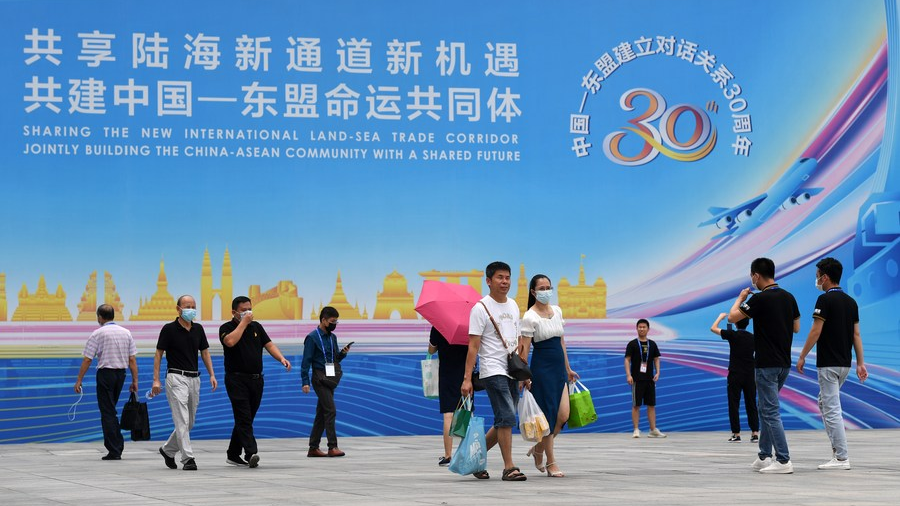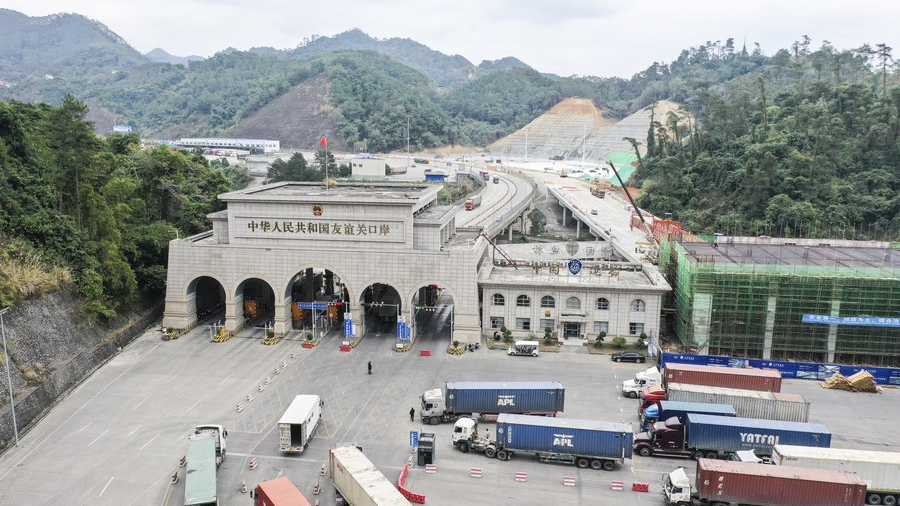
The venue of the 18th China-ASEAN Expo in Nanning, capital of south China's Guangxi Zhuang Autonomous Region, September 13, 2021. [Photo/Xinhua]
By Dai Yonghong
On October 26, the 38th and 39th ASEAN Summits and East Asia Cooperation Leaders' Meetings opened in Bandar Seri Begawan, capital of Brunei. With the recent slowdown of the COVID-19 epidemic in the ASEAN region, methods to assist in achieving economic recovery after the epidemic and avoiding a rebound of the epidemic will become the focus of discussion among participating ASEAN countries and dialogue partners. In addition, this year marks the 30th anniversary of the establishment of dialogue relations between China and ASEAN. Since the establishment of dialogue relations in 1991, China and ASEAN have embarked on a path of solidarity and a win-win cooperation.
To take the 30th anniversary as an opportunity to further unleash the potential of bilateral cooperation and build a higher level of China-ASEAN strategic partnership, it is necessary to clarify the strategic deployment under the ASEAN-Indo-Pacific vision and support the great significance of ASEAN centrality for China to properly handle relations between major countries, advance regional cooperation and build a community of shared future in its neighborhood.
ASEAN's anxiety: Great power game under Indo-Pacific strategy
The "Indo-Pacific Strategy" is a geopolitical framework for the United States to balance China's influence by integrating the Indo-Pacific region. As the heart of connecting the two oceans, ASEAN countries have important effects on the implementation of the strategy. In addition, the U.S., Japan, India, Australia, Britain, France, the European Union and other countries or regional organizations have released their own "printed" Indo-Pacific proposal and reaffirmed their support for the central position of the ASEAN countries to play a leading role in the regional affairs.

The port of the Friendship Pass on the China-Vietnam border in Pingxiang, south China's Guangxi Zhuang Autonomous Region, January 3, 2020. [Photo/Xinhua]
However, as the old saying goes, "the drinker's heart is not in the cup", the repeatedly shown good intentions towards ASEAN of some Western countries and organizations are in essence to bind ASEAN to the strategic decision of containing China and to counter the construction of the "Belt and Road Initiative" in South Asia, Southeast Asia and South Pacific islands. As the most influential regional organization in the Asia-Pacific region, ASEAN has also recognized the truth of being "favored", which has increased its strategic anxiety, worrying that the strategic competition between China and the U.S. will impact its unity and centrality.
ASEAN outlook on Indo-Pacific: Reconstruct central position and focus on development
In response to strategic anxiety, the 34th ASEAN Summit in September 2019, adopted the ASEAN Indo-Pacific Outlook, which elaborated ASEAN's position on the U.S.-led Indo-Pacific Initiative and demonstrated inclusiveness, different from the Indo-Pacific Strategy. ASEAN defines the Indo-Pacific as "a highly integrated and interconnected region"; ASEAN advocates "dialogue and co-operation" rather than "competition and containment"; stressing "development and prosperity for all" and "cooperation in a wider range of areas". This is fundamentally different from the U.S.'s positioning of the Indo-Pacific Strategy as competition or even containment against China. It also provides a diplomatic space for China to respond positively to the outlook.
For China, the ASEAN Indo-Pacific Outlook should not simply be relegated to the footnote of the U.S.'s Indo-Pacific strategy. Although ASEAN maintains moderate consistency with the U.S. in areas such as rights and interests in the South China Sea, infrastructure construction and non-traditional security, cooperation and development are at the core. China needs to actively establish economic and security regional mechanisms to deal with security threats from the Indo-Pacific region and to some extent ease the perception and doubts of the coastal countries on the so-called "threat" of China. On the other hand, China should follow the trend, seek cooperation opportunities with ASEAN in the complex security environment, and strive to find strategic opportunities in the process of deconstruction and reconstruction of regional maritime order.
China-ASEAN Future Cooperation: Promote a community with a shared future for mankind
The two sides should continue to deepen strategic mutual trust. China is ready to work with ASEAN to elevate the relations and continue to drive East Asia cooperation. The two sides should work together to defeat COVID-19. China will continue to take concrete actions to provide people in the region with useful and affordable public goods, to strengthen joint prevention and control, and upgrade public health cooperation. Both sides should make eager efforts to promote regional economic recovery. We will further implement the Regional Comprehensive Economic Partnership agreement (RCEP), promote cooperation in third-party markets, and jointly build high-quality Belt and Road projects.
The two sides should innovate in cultural exchanges. Humanity exchanges and cooperation are an important part of advancing the stability and long-term development of the China-ASEAN strategic partnership. The cooperation will continue to forge ahead and innovate, strengthen cooperation in the fields of culture, education, tourism, sports, youth, media, etc., do a good job in humanities exchange projects such as China-ASEAN Elite Scholarships, friendly cooperation theme short video contests, and learn from one another to enhance understanding and to promote people-to-people bonds on both sides.
In the future, China and ASEAN will join hands to seize the development opportunities of the digital economy and carry out the innovative 2.0 cooperation in e-commerce, smart cities, big data and 5G so as to promote common development and realize a community with a shared future for mankind.
The author is director of the Institute of Bengal Studies at Shenzhen University.

 中文
中文



